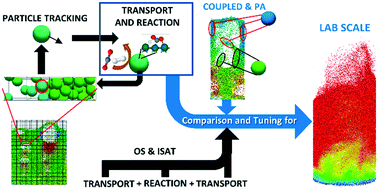当前位置:
X-MOL 学术
›
React. Chem. Eng.
›
论文详情
Our official English website, www.x-mol.net, welcomes your feedback! (Note: you will need to create a separate account there.)
Development and assessment of speed-up algorithms for the reactive CFD–DEM simulation of fluidized bed reactors
Reaction Chemistry & Engineering ( IF 3.9 ) Pub Date : 2019/12/24 , DOI: 10.1039/c9re00440h Riccardo Uglietti 1, 2, 3, 4, 5 , Mauro Bracconi 1, 2, 3, 4, 5 , Matteo Maestri 1, 2, 3, 4, 5
Reaction Chemistry & Engineering ( IF 3.9 ) Pub Date : 2019/12/24 , DOI: 10.1039/c9re00440h Riccardo Uglietti 1, 2, 3, 4, 5 , Mauro Bracconi 1, 2, 3, 4, 5 , Matteo Maestri 1, 2, 3, 4, 5
Affiliation

|
In this work, we propose a particle agglomeration (PA) speed-up algorithm to reduce the computational cost of the CFD–DEM framework based on the coupled solution (CP) of the gas–solid transport and heterogeneous reaction at the level of each particle in a fluidized bed reactor. The performances of PA are assessed and compared with the ones provided by the previously proposed operator-splitting (OS) and in situ adaptive tabulation (ISAT) speed-up algorithm. The analysis is carried out on methanation and steam reforming systems to investigate different reactions and transport characteristic times under different operating conditions. The results revealed that OS & ISAT is generally computationally more efficient by providing a higher chemical speed-up than CP & PA both in methanation (15 vs. 6) and steam reforming (13 vs. 4). However, OS requires a smaller simulation time step with respect to the CP to achieve convergent results when fast transport/reaction phenomena are considered. Hence, the overall computational cost might be even larger with respect to the CP despite the ISAT technique. Consequently, the selection of the best performing algorithm is not trivial and strongly depends on the characteristic times of transport and reaction which are a function of the local conditions experienced in the bed. Thus, we propose a strategy to select the most adequate algorithm (i.e., CP & PA or OS & ISAT). The strategy is based on the simulation of a test reactor characterized by a small computational cost but conceived to be representative of the chemical and fluid dynamic behavior of the target reactor. This enabled the simulation of a million particle methanation reactor experimentally investigated in the literature. A good agreement between simulation and experimental outlet concentrations (error up to 7% for the main species) is observed along with a significant 20-fold chemical speed-up.
中文翻译:

开发和评估流化床反应器的反应性CFD–DEM模拟的加速算法
在这项工作中,我们提出了一种粒子团聚(PA)加速算法,以基于每个粒子级别的气固传输和非均相反应的耦合解(CP)来降低CFD-DEM框架的计算成本在流化床反应器中。评估PA的性能,并将其与以前提出的操作员拆分(OS)和原位自适应制表(ISAT)加速算法提供的性能进行比较。在甲烷化和蒸汽重整系统上进行了分析,以研究在不同操作条件下的不同反应和传输特征时间。结果表明,甲烷化时,通过提供比CP和PA更高的化学提速,OS&ISAT通常在计算效率上更高(15 vs.6)和蒸汽重整(13 vs. 4)。但是,考虑到快速传输/反应现象,OS相对于CP要求更短的仿真时间步长,以达到收敛的结果。因此,尽管采用了ISAT技术,但相对于CP而言,总体计算成本甚至可能更大。因此,选择性能最佳的算法并非易事,并且很大程度上取决于运输和反应的特征时间,这些特征是床中所经历的局部条件的函数。因此,我们提出一种策略来选择最合适的算法(即,CP和PA或OS和ISAT)。该策略基于对测试反应器的仿真,该仿真器的计算成本较低,但被认为可以代表目标反应器的化学和流体动力学行为。这使得能够对文献中实验研究的百万颗粒甲烷化反应器进行仿真。观察到模拟与实验出口浓度之间的良好一致性(主要物种的误差最高为7%),并且化学速度显着提高了20倍。
更新日期:2020-02-13
中文翻译:

开发和评估流化床反应器的反应性CFD–DEM模拟的加速算法
在这项工作中,我们提出了一种粒子团聚(PA)加速算法,以基于每个粒子级别的气固传输和非均相反应的耦合解(CP)来降低CFD-DEM框架的计算成本在流化床反应器中。评估PA的性能,并将其与以前提出的操作员拆分(OS)和原位自适应制表(ISAT)加速算法提供的性能进行比较。在甲烷化和蒸汽重整系统上进行了分析,以研究在不同操作条件下的不同反应和传输特征时间。结果表明,甲烷化时,通过提供比CP和PA更高的化学提速,OS&ISAT通常在计算效率上更高(15 vs.6)和蒸汽重整(13 vs. 4)。但是,考虑到快速传输/反应现象,OS相对于CP要求更短的仿真时间步长,以达到收敛的结果。因此,尽管采用了ISAT技术,但相对于CP而言,总体计算成本甚至可能更大。因此,选择性能最佳的算法并非易事,并且很大程度上取决于运输和反应的特征时间,这些特征是床中所经历的局部条件的函数。因此,我们提出一种策略来选择最合适的算法(即,CP和PA或OS和ISAT)。该策略基于对测试反应器的仿真,该仿真器的计算成本较低,但被认为可以代表目标反应器的化学和流体动力学行为。这使得能够对文献中实验研究的百万颗粒甲烷化反应器进行仿真。观察到模拟与实验出口浓度之间的良好一致性(主要物种的误差最高为7%),并且化学速度显着提高了20倍。



























 京公网安备 11010802027423号
京公网安备 11010802027423号